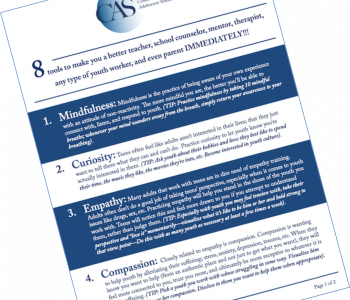

Catharine Hannay, MA
Catharine Hannay is the founder of MindfulTeachers.org and the author of Being You: A Girl’s Guide to Mindfulness, a workbook for teen girls on mindfulness, compassion, and self-acceptance.
Five Mindfulness Activities for Each of the Five Senses
Here are twenty-five different activities you can try with your students or clients to add some fun variety to your mindfulness lessons.
Focusing on the five senses can also be a good alternative to breath-based practices for youth who suffer from anxiety or who’ve been impacted by trauma.
Sense of Sight
- World of Color
“Collect paint chips from a paint or hardware store. Find colors you respond to in the world. Attempt to match them using the chips. (You can also match the colors using a portable paint set.) Make notes of where you saw the colors.”
(from How to Be an Explorer of the World, by Keri Smith)
- One Object, Many Views
Pick an object to examine in as many different ways as possible. “Look at it in a mirror, squint at it, block part of it with your hand […] look at it from far away and close up.”
(from Life in Five Senses by Gretchen Rubin, p. 225)
- Mindful Photography
This is a good way to focus on little things in your surroundings that you might not usually pay attention to.
“Notice your emotions, including perhaps a craving to get the next good shot. Sometimes, wanting to take a photo can get in the way of directly experiencing what is present.”
(from Secular Meditation, by Rick Heller)
- Human Camera
With a partner, take turns being the ‘photographer’ and the ‘camera.’
“The photographer walks behind her ‘camera,] with hands on her camera’s shoulders. She carefully guides her partner, who keeps his eyes closed. […] When she’s ready to take the picture, she gently squeezes her partner’s shoulders.”
The ‘camera’ quickly opens and closes his eyes to ‘take the picture.’ After three ‘pictures,’ the partners switch places.
(from Planting Seeds: Practicing Mindfulness with Children, by Thich Nhat Hanh and the Plum Village Community)
- Blue-Red-Yellow: What You See Depends on What You’re Looking for
Close your eyes, take a couple of breaths, and think about the color blue. Now open your eyes and look around.
Do the same thing with red, and then with yellow.
Isn’t it amazing how you see something different each time, depending on what you’re focusing on?
Can you think of any ways this is true in other situations?
(from “Blue Red Yellow: What Do You See?” by Catharine Hannay at MindfulTeachers.org)
Sense of Hearing
- Birdsong
“Download a birdsong-identification app and identify the birds around you.”
(from Life in Five Senses by Gretchen Rubin, p. 226)
- Counting Sounds
How many different types of sounds can you identify while walking down the street or at your local park?
(from “Counting Sounds: A Mindful Walking Practice” by Catharine Hannay at MindfulTeachers.org)
- Sound Seekers
Each youth makes a different sound with his or her body. For example, “Snap fingers, clap hands, slap knees, stomp feet, or smack lips. Another player is brought blindfolded into the group and has to find a certain sound, say finger snapping. The seeker wanders among the sound makers until the one making the identified sound is found.”
(from Self-Esteem Games by Barbara Sher)
- Awareness of Sounds and Silence
Pay attention to the rhythms of the sounds and noises you hear throughout the day. “Is there a time when the sound is there, but not the noise? Or a moment of silence between the sounds? […] Take a moment to appreciate how the sound highlights the silence, and the silence highlights the sound.”
(from “Mindful Listening in a Noisy World” by Ira Rabois at MindfulTeachers.org)
- A Mindful Response to Distractions
“Think about what happens when you lose your concentration. Do you start yelling inside? Do you yell at whatever or whoever is making the sounds? Do you yell at yourself for not being better able to focus? […] When something disturbs or distracts you from what you would rather be doing, instead of getting lost in worry or anger[…] simply breathe in and notice how you are responding to whatever is there for you. Notice any thoughts or patterns of thought passing through your mind.”
(from “Mindful Listening in a Noisy World” by Ira Rabois at MindfulTeachers.org)
Sense of Touch
- Baby Touch
“One of my friends had a little baby who was just starting to crawl. They had a great time exploring the floor together because the baby was so excited by the different textures. […] Try touching the everyday objects around you as if you’re exploring the world for the first time. How many different textures can you find?”
(from Being You: A Girl’s Guide to Mindfulness, by Catharine Hannay, p.19-20 )
- Blindfold Touch
Assemble a variety of different objects, such as “a rubber ball, a silk scarf, a piece of ceramic, a Velcro fastener[…] a bowl of ice […] Put on a blindfold and explore them all with receptive, listening hands. Describe the textures, weight, temperature, and other sensations.”
(from How to Think Like Leonardo da Vinci by Michael J. Gelb)
- Cornstarch
Rub some cornstarch between your fingers. Now add water and feel the difference in texture.
(from Life in Five Senses by Gretchen Rubin, p. p. 230)
- Tactile Board
“Collect materials based on texture. Glue the textures on a sheet of paper or cardboard. Invite people to close their eyes and guess what the different materials are.”
(from How to Be an Explorer of the World by Keri Smith)
- Focus on Your Feet
“What do the bottoms of your feet feel like when you’re walking? How do they feel when you’re walking inside or outside, or when you’re wearing a different pair of shoes, slippers, or sandals?”
(from Being You: A Girl’s Guide to Mindfulness, by Catharine Hannay, p. 19 )
Sense of Taste
- Five Senses Snack
Enjoy your favorite treat even more by focusing on the five senses. What color, shape, and texture do you see? What can you feel, with your fingers and inside your mouth? What can you hear as you open the package or as you chew? What words can you use to describe its taste and smell?
(from “Five Senses Snack: A Mindful Eating Chart” by Catharine Hannay at MindfulTeachers.org)
- Mindful or Mindless Treat
“For this activity, you’ll need two very small servings or a food you enjoy eating. For example, you could try two pieces of your favorite candy, two berries, or two slices of apple.
- Eat the first little treat in the way you normally would.
- Then pick up the second treat, put it in your mouth, and chew it ve-e-ry slowly, paying attention to all the sensations in your mouth.
- Did you have a different experience the second time?”
(from Being You: A Girl’s Guide to Mindfulness, by Catharine Hannay, p. 23)
- Mindful Chocolate Experiment
“Consider the wrapped chocolate – Does the wrapper make a sound? What colour is it? […] Look at the chocolate. Consider its texture, colour, weight… Smell the chocolate – does the smell trigger any other senses? […] Place the chocolate in your mouth but DO NOT EAT!! How does it feel as it melts? Where in your mouth can you taste it? […] Move the chocolate around your mouth Does the area of taste change? Does the taste itself change? […] Swallow the chocolate, focusing on the sensation. Is there a lingering taste? How do you feel physically and emotionally?”
(from “Mindfulness and the Art of Chocolate Eating” by Meditation in Schools)
- Ketchup and Vanilla
“Pull out a bottle of ketchup and pay close attention as you put a few drops on your tongue. […] Now try ketchup with another food. How does it change the flavor you experience? Now try vanilla—breathe in its scent, taste a drop, notice how it enhances flavors when you add it.”
(from Life in Five Senses by Gretchen Rubin, p. 229)
- 5. A Mindful Taste Test
“Gather several bite-sized treats, like pieces of fruit, candy, nuts, or spoonfuls of jam. […]
Compare different flavors of food in the same category, such as:
- pieces of white, milk, and dark chocolate;
- raspberry, strawberry, and blueberry jam; or
- different types of honey.
Or compare the same type of food, but different brands, like:
- different brands of milk chocolate or dark chocolate, or
- different brands of strawberry jam.”
(from Being You: A Girl’s Guide to Mindfulness, by Catharine Hannay, p. 25)
Sense of Smell
- What Do You Smell Right Now?
“Describe what you smell, right now, as vividly as you can… Breathe in the smells of [a] book, an empty coffee cup, the palm of your hand, the back of your chair.”
(from How to Think Like Leonardo da Vinci by Michael J. Gelb)
- Spice Up Your Life
“Today carry a sprig of fresh or dried spice like basil or rosemary in your pocket. […] Reach into your pocket and squeeze the spice with your fingertips. Then smell its fragrance on your fingertips, and watch yourself snap back in to the pleasure of wonder.”
(from It’s Only Too Late If You Don’t Start Now by Barbara Sher)
- Jelly Bean
“Plug your nose and put a jelly bean in your mouth, then unplug your nose and notice how the flavor changes.”
(from Life in Five Senses by Gretchen Rubin, p. p. 227)
- Stop and Smell the Roses
“The next time you stop to smell the roses (literally), or hold your coffee or cup of tea under your nose, or smell the aromas when you cook, try these few steps:
- a)Close your eyes and slowly inhale […]
- b)Mindfully pause – take a moment and rest your awareness on the present-moment experience of smelling […]
- c)Identify any memories it triggers – notice any pleasant and/or unpleasant memories and simply open up and accept these images without judgment […]
- d)Bring your attention back to the act of smelling, open your eyes and continue with your day in a mindful way.”
(from “Stop and Smell the Roses: Discover Mindful Smelling,” at attunedpsychology.com)
- The Sense of Scents
“Gather several types of food or substances with different fragrances.
Here are a few suggestions:
- perfume, cologne, or scented soap;
- different types of tea or coffee;
- herbs and spices like basil and cinnamon; and
- plants with a strong scent, like pine needles.
Close your eyes if that feels comfortable to you. […] Select one of your substances. Sniff deeply. […] Think about your reaction to this scent. Do you like it? Does it remind you of something? What thoughts or feelings does it evoke?”
(from Being You: A Girl’s Guide to Mindfulness, by Catharine Hannay, p. 22)
If you like these types of exercises, you can find more five senses activities, and a wide range of other resources on sharing mindfulness with youth, at MindfulTeachers.org.
Join the FREE Resilience Community for Helping Professionals to learn more about mindfulness, resilience, trauma-informed care, building relationships, and more! Our community features self-paced courses, a monthly live Zoom call, a weekly live meditation, and an online platform to connect with other providers/professionals in your field.
Related Posts
A Dozen Songs for Teaching Mindfulness to Teens
Teaching Meditation to Teens Who Have the Giggles
9 Guidelines for Teaching Trauma-Informed Mindfulness to Teens
3 Tips for Using Mindfulness in Substance Abuse Treatment with Adolescents

